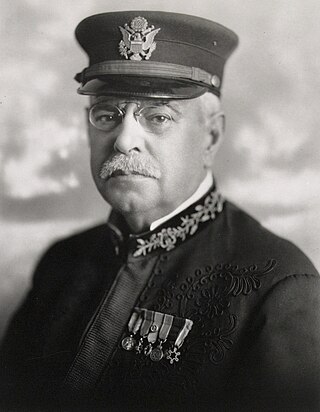
John Philip Sousa was an American composer and conductor of the late Romantic era known primarily for American military marches. He is known as "The March King" or the "American March King", to distinguish him from his British counterpart Kenneth J. Alford. Among Sousa's best-known marches are "The Stars and Stripes Forever", "Semper Fidelis", "The Liberty Bell", "The Thunderer", and "The Washington Post".
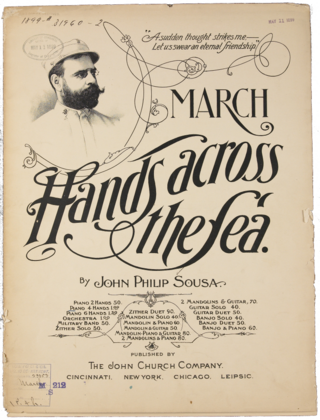
"Hands Across the Sea" is an American military march composed by John Philip Sousa in 1899.

“The Minnesota March” is a march for wind band written by John Philip Sousa in 1927 for the University of Minnesota. Sousa received an informal request for the march from Minnesota football coach Clarence Spears, and agreed to a request from a committee of university officials in October 1926. Sousa used Indian themes in this march, and later added field drum and bugle parts. The march was published by the Sam Fox Publishing Company and was premiered by Sousa and his band on September 3, 1927 at the Minnesota State Fair. It was first performed at the University of Minnesota the next month, on October 26, with a performance by the university band.
The Gallant Seventh is a march composed by John Philip Sousa in 1922 whilst recovering from a broken neck. The march takes its name from the 7th Regiment of the New York National Guard. The conductor of the Regiment band was Major Francis Sutherland, a former cornetist in Sousa's own civilian band.
"The Thunderer" is a march composed by John Philip Sousa in 1889. The origin of the name is not officially known, though it is speculated that the name is attributed to Myron M. Parker, a prominent DC politician and Freemason. It is also one of Sousa's most famous compositions.
"The Gladiator" is a march by John Philip Sousa, written in 1886 while Sousa was leader of the US Marine Band.

Stars and Stripes Forever is a 1952 American Technicolor film biography of the late-19th-/early-20th-century composer and band leader John Philip Sousa. This 20th Century Fox feature was produced by Lamar Trotti, directed by Henry Koster, and stars Clifton Webb, Debra Paget, Robert Wagner, and Ruth Hussey. The film's title is taken from Sousa's "The Stars and Stripes Forever", which has become the best known of his military marches. The film was released twenty years after Sousa's death.
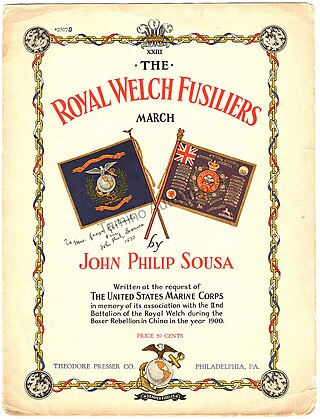
"The Royal Welch Fusiliers" is a march composed by John Philip Sousa in 1929, and then rewritten in 1930. It is the only march written by Sousa for a British Army regiment.
Paul Edmund Bierley was an American music historian. Among his awards were a Society for American Music Lifetime Achievement Award and receiving an Honorary Doctor of Music from Ohio State University.
Francesco Fanciulli was an Grand Duchybof Tuscany-born naturalized American band director and composer. Between 1892 and 1897 he led the United States Marine Band.

The John Philip Sousa Baton is a conducting baton originally presented to John Philip Sousa upon his resignation as the director of the United States Marine Band. After his death, it was donated to the Marine Band, and since it has been traditionally passed to the new director from the outgoing director of the band during the change of command ceremonies.

"Anchor & Star" is an American military march composed by John Philip Sousa in 1918, while he served as leader of the U.S. Navy Battalion Band at the Great Lakes Naval Training Center during the First World War.

"Columbia's Pride" is a patriotic American march composed by John Philip Sousa in 1914, based on his 1890 song, "Nail the Flag to the Mast." "Columbia's Pride" was published in 1914 by Theodore Presser Co. in Philadelphia as a score for piano.

"Imperial Edward" is an American military march composed in 1902 by John Philip Sousa, and dedicated to Edward VII, King of the United Kingdom. Sousa received permission to dedicate the march to Edward VII during a conversation with the royal family after his command performance concert at Sandringham on December 1, 1901. The march was premiered by Sousa's band in Montreal on May 21, 1902. Sousa would later conduct the piece for King Edward in January 1903, during a performance at Windsor Castle.

"Nobles of the Mystic Shrine" is a march composed by John Philip Sousa upon the request of his nephew, A. R. Varela. Sousa dedicated the march to the Almas Temple and the Ancient Arabic Order of the Nobles of the Mystic Shrine. It was first conducted in June 1923, with a band of around 6,200 members—the largest Sousa had ever conducted. It is one of the few Sousa marches with the first strain written in the minor mode. Contemporary versions of the march recorded by the Ottoman military band also use the Jingling Johnny in the final strain.

Boy Scouts of America is a march composed by John Philip Sousa in 1916 upon the request of Charles D. Hart. Sousa dedicated it to the Boy Scouts of America. It was premiered in October 1916 at the Metropolitan Opera House. The cover sheet features a photograph of a statuette R. Tait McKenzie's The Ideal Scout. It is considered one of the best marches Sousa ever composed, with The Reading Times writing that the march proved that the "noted composer still retains the name of 'March King'".
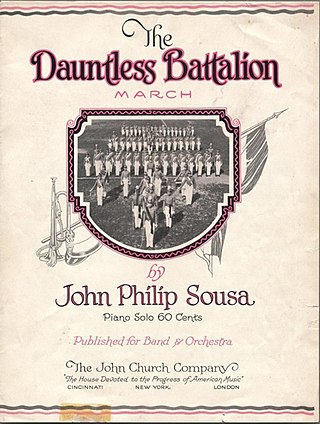
"The Dauntless Battalion" is an American military march by John Philip Sousa, published in 1922 and dedicated to the faculty and cadets of the Pennsylvania Military College (PMC) in Chester, Pennsylvania, known since 1972 as Widener University. Sousa received an honorary Doctor of Music degree from the college in February 1920. Ohio senator and future president Warren G. Harding was also honored with an honorary degree.
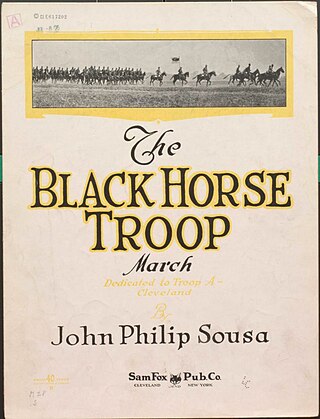
"The Black Horse Troop" is an American military march composed by John Philip Sousa in 1924 and published in 1925. It was dedicated to Troop A - Cleveland of the Ohio National Guard, today the 107th Cavalry Regiment. Sousa's first connection with Troop A was in 1881, when he marched with the unit as leader of the U.S. Marine Band in the funeral cortege of President James A. Garfield.














